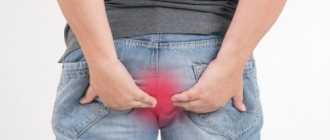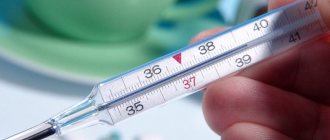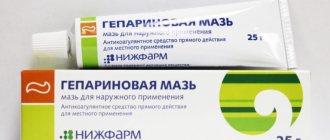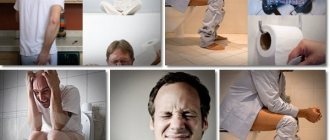If a person monitors his health, then he tends to notice even small changes and disruptions in the functioning of the body, and even those who usually treat their body carelessly will notice discharge from the rectum. Usually people are embarrassed about their delicate problem and do not rush to the doctor, hoping that everything will go away on its own.
However, such an attitude is fraught with serious and unpleasant complications. If there is discharge from the anus due to hemorrhoids in the form of a viscous slippery mass, blood, pus or oily formations, then this is a reason for an urgent visit to the doctor.
Causes of rectal discharge
The attending physician has more than once examined patients who have weeping hemorrhoids or another form of it with discharge. There is nothing to be ashamed of - the main thing is not to let it go.
This phenomenon can be caused by:
- food poisoning;
- vascular abnormalities or neoplasms;
- recent surgery in this area;
- papillomas;
- irritable bowel syndrome;
- bacterial infection.
But one of the most common reasons why discharge is formed is hemorrhoidal bumps, in the presence of which the discharge is usually red in color, and its cloudiness indicates serious complications. Discharge is also provoked by another symptom of hemorrhoids – anal fissures.
It is noteworthy that the discharge is not necessarily associated with bowel movement - it can also be spontaneous.
Is discharge a symptom of complications?
Normally, mucus is constantly present on the intestinal walls. It is secreted by special cells and is needed to facilitate the passage of feces and protect the mucous membrane . It may be released a little during bowel movements, but it is usually not noticeable.
Mucus is released in large quantities in the presence of inflammation. This often happens with hemorrhoids, but the mucous discharge should be slight and transparent. If there are a lot of them, they occur regardless of bowel movements, they are mixed with pus or blood - this indicates the development of complications.
Reasons for appearance
Mucous discharge from hemorrhoids appears during a severe inflammatory process . Violation of the outflow of venous blood leads to irritation of the glands and excessive mucus production. If there is a lot of it and blood impurities appear, this indicates a rupture of the internal hemorrhoid or the formation of ulcers on the walls of the rectum. If thick greenish mucus with pus and an unpleasant odor appears, paraproctitis can be suspected - inflammation of the tissues around the rectum .
In addition, long-term hemorrhoids can lead to complications associated with intestinal dysfunction. In this case, pain occurs in the lower abdomen, defecation problems, and a sensation of a foreign body in the rectum. These symptoms may indicate the following diseases:
- ulcerative colitis;
- Crohn's disease;
- herpes of the rectum;
- intestinal tuberculosis, gonorrhea;
- tumors, condylomas, polyps or cysts;
- irritable bowel syndrome;
- proctitis, sigmoiditis.
Attention! When diagnosing the causes of mucus on underwear in women, it is necessary to exclude vaginosis and fungal diseases.
Is there an unpleasant smell?
With uncomplicated hemorrhoids, the smell from stool and discharge is normal, like that of a healthy person . If the disease is complicated by paraproctitis, the mucus can become foul-smelling. This is due to the fact that waste products of microorganisms, particles of decaying tissue, and pus get into it.
Constant moisture in the anal area leads to the formation of ulcers, wounds and cracks. Feces get into them, and purulent inflammation develops, which is also accompanied by the release of foul-smelling mucus.
An unpleasant odor may appear when treated with traditional methods , for example, it is often caused by honey or milk. And if foul-smelling discharge is accompanied by a high temperature, this indicates the presence of an intestinal infection.
Mucous discharge as a reason to be wary
Patients suffering from hemorrhoids do not always consider mucus in the stool as a reason to see a doctor, believing that this is a common symptom of the disease that does not require special treatment. However, if this discharge is cloudy or has any tint, if there is a colored coating on the hemorrhoids, you should definitely see a specialist. Such symptoms of discharge may indicate the occurrence of complications or some concomitant pathology.
You should be especially wary if the discharge has become more abundant and frequent, bloody plaque has appeared on the hemorrhoids or pus has appeared on the anus, accompanied by the release of cloudy mucus. Another serious cause for concern is greenish discharge with white or orange streaks. If any of these signs occur, you should definitely go to the hospital!
Purulent formations after surgery
Purulent discharge after surgery to remove hemorrhoids can occur as a result of the penetration of pathogenic microbes from the stool into the injured area. Antibacterial agents are used to eliminate purulent formation. With significant suppuration, painful formations are drained and then treated with conservative methods using ointments, suppositories, and compresses.
It is necessary to understand that if purulent hemorrhoids have formed, it will not be easy to cure. For example, a complication of hemorrhoids, such as paraproctitis, is fraught with the formation of fistulas in the intestines. A fistula is an unhealed canal through which pus flowed. A fistula can only be cured through surgery. Without intervention, the pathology can return or develop into cancer.
Specifics of the appearance of mucus in hemorrhoids
Depending on how active the course of the disease is (acute or chronic), the stage and location (internal, external, combined hemorrhoids), the discharge also differs. Thus, with acute prolapse of hemorrhoids, hidden rectal bleeding is observed.
This pathology is revealed only by examining stool using laboratory methods, since blood accumulates in the ampulla of the rectum. When the pathological process lasts long enough, anemia is possible.
Exacerbation of the disease in women accompanies pregnancy, stress and excessive physical activity. In men it can be caused by alcohol or spicy food.
Oily discharge
Such discharge accompanies bowel movements, has a characteristic shine, and is quite difficult to wash off the toilet. They are usually accompanied by the formation of internal hemorrhoidal cones, but there may be other reasons.
For example, in women they accompany the use of oral contraceptives or dietary supplements that are aimed at weight loss. In addition, such discharge is characteristic of excessive consumption of fatty fish or tomatoes.
However, there are also more serious causes - such as inflammation of the gallbladder/biliary tract, colitis or inflammation of the pancreas.
Since it is impossible to independently determine why such discharge appeared, you need to consult a professional.
About weeping hemorrhoids
Weeping hemorrhoids are the fourth stage of the disease, characterized by significant complications. At this advanced stage, hemorrhoids “hide” inside, and with the slightest effort (not only straining or defecation, but also sneezing) they fall out, and the patient himself can no longer set them.
What is especially unpleasant is that the sphincter becomes so inelastic that it cannot hold feces. In addition, the protruding hemorrhoidal node or nodes hang down and prevent the anus from closing. The logical result of this is the leakage of mucus, and in the most severe cases, involuntary bowel movements.
From the above, we can conclude that the causes of a weeping sphincter are incompetence and damage to the sphincter, as well as its incomplete closure due to knots.

Symptoms
Weeping hemorrhoids have the main symptom of this stage of the disease - prolapse of hemorrhoids from the anus, which is permanent. Moreover, due to the fact that the nodes fall out from the slightest effort and cannot be adjusted on their own, usually they simply constantly hang out of the anus. Weeping hemorrhoids also have other symptoms:
- constantly open sphincter;
- mucus is released from the anus;
- moisture in the anal area, so that the patient is forced to regularly blot this area with thin paper napkins, perform hygiene procedures several times a day, thoroughly drying the affected area after them;
- Itching of the anus is constantly irritated.
In addition, weeping hemorrhoids are accompanied by bloody discharge, but the patient does not experience severe pain at this stage.
There is pus with hemorrhoids
Pus from hemorrhoids is a common and frequent complication. Discharge is especially noticeable during the act of defecation; it comes out of the anus before and after feces. Sometimes blood and pus appear with hemorrhoids; such fluids are noticed both regularly during bowel movements and spontaneously. Purulent hemorrhoids are a consequence of the appearance of thrombosis in the nodes or the result of the presence of paraproctitis (pus affects the tissue around the intestine). The symptom indicates a dangerous human condition and requires timely treatment.
Hemorrhoids with pus are a clear symptom of inflammation in the intestines. The disease has characteristic sensations:
- pain syndrome;
- burning;
- severe itching;
- swelling of the hemorrhoidal area;
- discharge of fluid from the anus.
Hemorrhoids can cause purulent discharge of various compositions.
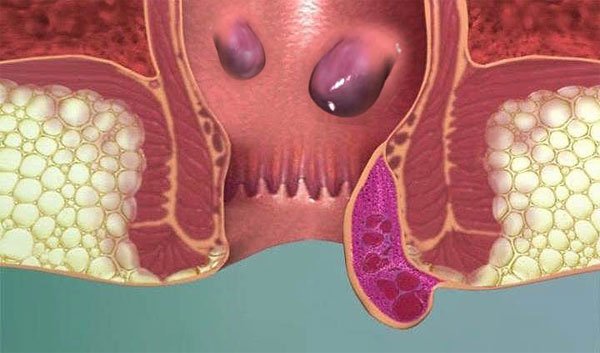
When a blood clot forms in the area of the hemorrhoid or suppuration of the tissues surrounding the rectum, purulent hemorrhoids occur
Depending on the form of the disease, the affected area and the cause of the disease, there are different forms of hemorrhoids:
- by localization: acute: subcutaneous, retrorectal and submucosal;
- chronic, according to the location of the focus: front, side and back.
- acute: simple, anaerobic, after injury and specific;
- simple;
Not in all cases, hemorrhoids fester; inflammation can occur in a simple form and cause a minimal amount of negative effects.
Hemorrhoids with suppuration are formed due to 3 main conditions:
- the presence of a thrombus in the node. If treated, discharge from hemorrhoids begins only after the inflammatory process worsens. Swelling in the rectal area gradually increases and an abscess appears. The development of inflammation leads to the formation of a blood clot, which contributes to the appearance of swelling in the nearby area. Necrosis and festering hemorrhoids soon appear;
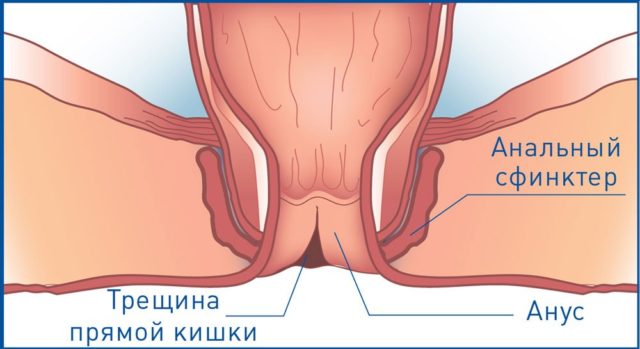
The appearance of such a pathology indicates the presence of severe inflammatory processes in the rectum
- paraproctitis in purulent form. Refers to inflammation in the intestines, but in a complicated form. When the disease appears, the quality of the microflora of the stomach and intestines is disrupted. Soon the prerequisites for the appearance of acute and severe forms of inflammation appear;
- anal fissures trigger processes with negative consequences for the intestines. Purulent discharge from hemorrhoids does not appear for no reason; they are complications from the long-term chronic course of the disease.
The discharge of pus is not always provoked by suppuration of the nodes; there are other disorders in the body that provoke a similar condition.
Purulent discharge and hemorrhoids can provoke the following conditions:
- Ulcerative colitis is an acute inflammation localized in the gastrointestinal tract. The disease is often accompanied by patches of blood in the mucus;
- the presence of tumors regardless of their quality;
- fistula of the perirectal space. Pus is not released from the anus, but through the fistula. It can be seen just behind the nodes;
- negative reaction of the body to surgery performed in the rectal area or intestines. This is a dangerous condition because the pus from hemorrhoid removal leads to the opening of the area where the operation was performed. Feces with all dangerous microorganisms can enter the site of the intervention, which creates a risk of various complications.
The disease is a consequence of a passive lifestyle, excess body weight, consumption of large amounts of junk food, alcoholic beverages, etc. Hemorrhoids appear in half of all women after childbirth.
Discharge from hemorrhoids - symptoms:
- discomfort in the hemorrhoidal area;
- burning and itching are manifestations of mucous secretions that have an irritating effect on the skin. The appearance of fluid is a consequence of the inflammatory process in the walls;
- bleeding occurs in most cases of the disease. It can be almost invisible, and given the appearance of fluid only after bowel movements, blood may not be noticed. To determine the presence of blood clots, you need to examine the surface of the stool. In some cases, drops or stream may appear after defecation;
- nodes falling out. Initially, the symptom becomes noticeable only with severe stress, often with constipation. Over time, loss occurs every time you have a bowel movement, and then for no apparent reason or with minimal exertion. At the initial stages, the nodes do not require reduction; they return on their own. If the condition worsens, you have to contact a specialist for adjustment.
If the listed symptoms appear, perhaps some of them, you need to contact a proctologist. The delicacy of the problem leads to embarrassment for some patients, which is why people often seek help in the later stages of the disease. As it progresses, the risk of complications increases.

The disease manifests itself as pain, burning and itching in the anus
The appearance of paraproctitis can be provoked by the general condition of the body or illness. Among the main causes and risk factors:
- decreased immune function;
- exhaustion of the body;
- chronic pathologies;
- infectious diseases of the gastrointestinal tract in chronic or acute form;
- frequent diarrhea or constipation;
- proctological diseases: simple hemorrhoids, fissure, papillitis, proctitis, cryptitis.
Pus from hemorrhoids can also mask other diseases that affect the intestines.
An abscess with hemorrhoids should be treated only under the supervision of a proctologist. With timely treatment, a specialist will help prevent complications and speed up recovery. Based on what pus looks like in hemorrhoids, you can learn about the involvement of other organs and the degree of neglect of the condition. As the source of inflammation spreads, the pelvic organs are involved in the pathological process. For men, the most common lesion is the urinary canal, and for women - the vaginal area.
source
Purulent hemorrhoids are a delicate and very unpleasant problem that a huge number of people face.
It is very common, however, even those who suffer from this problem try not to advertise it and fight with their own methods, which does not always lead to a successful result.
A particularly unpleasant and, at the same time, dangerous stage of this disease is the appearance of pus. Purulent hemorrhoids can be dealt with successfully and quickly if you take the right measures.
Let's look at the reasons for the appearance and development of hemorrhoids:
- Passive lifestyle.
- Excessive consumption of spicy foods.
- Problems with obesity.
- Alcoholism.
- It is also often a consequence of childbirth.
Purulent discharge from hemorrhoids occurs because the patient did not take care of timely treatment for this unpleasant disease, did not consult a doctor and, most likely, did not take basic measures to combat the disease.
After all, pus appears already at the third stage of the disease, which can be called advanced . Fortunately, this is not as critical as it seems, so treatment will not take much time.
Pus can appear for two reasons. Both of them are associated with delayed therapy:
- The occurrence of blood clots in hemorrhoids. As a rule, it causes swelling and the appearance of pus. This leads to the development of the following disease;
- Paraproctitis with discharge of pus. It is caused by thrombosis, wall rupture, inflammation or mixed microflora. It is this term that is most often referred to as hemorrhoids with the discharge of pus.
Pus is a truly alarming sign, so its appearance should force even the most careless patient to turn to specialists, because it is difficult to cure such an illness on your own, and therapy will take much longer.
The fact is that when such discharge appears, there is a high risk that the pus will spread to areas of the pelvis, where it will cause inflammation and swelling .
A symptom of purulent hemorrhoids is not only the presence of discharge, but also an increase in body temperature, weakness and other signs inherent in intoxication.
There may be false urges to go to the toilet “in a big way.” All this indicates the seriousness of the problem. Therefore, do not delay treatment!
If purulent hemorrhoids are in a completely advanced stage, then there is no alternative to the surgical method.
During the operation, the doctor opens the abscess, removes the discharge, and only then carries out the usual manipulations for the treatment of hemorrhoids.
As a rule, a person feels almost instant relief : body temperature normalizes, symptoms of body poisoning disappear.
But it is quite possible to do without surgical intervention if you go to a specialist in time.
Treatment of purulent hemorrhoids can be carried out with medication. However, the therapy process must be prescribed by a doctor. It is advisable that he monitor the progress of treatment.
As a rule, enemas or suppositories are used to treat this disease; they penetrate well directly into the intestine, making them more effective than any other method of drug treatment.
Antibiotics against purulent inflammation in hemorrhoids will also be necessary. After all, the discharge contains a huge amount of harmful substances that simply clog the body. Because of this, more than serious harm to the patient’s health can be caused.
As a rule , when intoxicated, the body is weakened and resists illnesses extremely sluggishly. Therefore, it is necessary to take a course of antibiotics to destroy harmful bacteria inside the body.
In addition, if the patient has a high fever, he is also prescribed a similar method of therapy. Remember that only a doctor determines what medications and ointments to use for purulent hemorrhoids, so do not pay attention to advertising that promises to get you back on your feet in one sitting.
Also, in support of drug treatment, you can use folk remedies that will help you cope with the disease faster, using the power of nature.
There are several good options for treating hemorrhoids with purulent discharge at home:
- Salt baths: a tablespoon of salt and soda is diluted with 5 liters of water, after which you immerse yourself in this solution for 10 minutes. This procedure will help reduce pain and pus discharge;
- Also, instead of salt, you can use various decoctions of rowan, yarrow, calendula, chamomile, and St. John's wort for baths. These plants help reduce inflammatory processes, so that discharge will not bother you;
- Enemas with a small amount of honey or the above-mentioned decoctions help greatly, because this way the active substances penetrate better into the affected area, which means the effect is more effective.
To ensure that purulent hemorrhoids no longer bother you, you should normalize your diet and eliminate the consumption of alcohol and spicy foods. It is also recommended to engage in regular physical activity and avoid spending large amounts of time sitting.
All this will help you say goodbye to paraproctitis forever and forget about purulent hemorrhoids!
source
Mucous, bloody or purulent discharge from hemorrhoids is a fairly common symptom of this disease, which brings a lot of inconvenience to patients. But stains on underwear are not the whole problem, because the appearance of mucus, blood or pus in the stool may also indicate the presence of other diseases, in particular colon cancer. Therefore, it is important to know which types of discharge are acceptable for hemorrhoids, and which are a warning sign, as well as why they appear and how to get rid of them. We suggest you look into this.
Acute and chronic hemorrhoids are characterized by several types of discharge, namely:
Mucous discharge is the discharge of a clear, colorless, viscous liquid from the anus. In cases where the disease is accompanied by bleeding or purulent complications, this fluid can change its character to muco-bloody, muco-purulent, etc. Accordingly, the admixture of blood in the mucus gives it reddish, brown or cherry shades, and pus – yellow or greenish .
Mucous discharge in the initial stages of hemorrhoids is released only during bowel movements. But with the progression of hemorrhoids, the muscles of the anus weaken, so mucus constantly leaks from the rectal canal, which leads to irritation of the skin of the anal area, the appearance of ulcers and erosions. All this is manifested by severe itching, pain and burning, which bring a lot of suffering to patients.
Bloody discharge is characteristic of rectal bleeding, which occurs from damage to both internal and external hemorrhoids by hard feces. With hemorrhoids, hemorrhoidal bleeding is always associated with the act of defecation, unlike other diseases, such as colon cancer.
With hemorrhoidal bleeding, blood is always detected on the surface of the stool in the form of stripes. The patient may also notice drops of blood on the toilet or toilet paper. Massive bleeding in patients with hemorrhoids is rarely observed, mainly in advanced stages of the disease.
The appearance of pus in the stool of patients with hemorrhoids is almost always a sign of the development of infectious complications of the disease, such as suppuration of a thrombosed node, paraproctitis and proctitis. Purulent discharge always smells unpleasant and can be white, yellowish, brown or greenish in color, depending on the type of pathogen.
Oily discharge from patients with hemorrhoids is an oily, thick mass of brown color with an orange tint. Such discharge can appear in the feces and be released during defecation, leaving stains on the toilet, underwear, clothes and even the surface of the chair during prolonged sitting.
Now let’s look at what causes the appearance of rectal discharge with hemorrhoids.
As we have already said, mucous discharge is the most common type of discharge for hemorrhoids.
Mucus is the secretion of goblet glandular cells of the mucous membrane of the digestive tract, the main purpose of which is to facilitate the passage of feces.
Pathology is indicated when the amount of intestinal mucus that is released during bowel movements or posture increases. In addition, changes in the nature and color of mucus, as well as the appearance of an unpleasant odor, are considered a sign of the development of pathology.
Patients with hemorrhoids, in addition to mucus discharge from the rectal canal, are also concerned about other symptoms, such as:
- discomfort in the anus;
- feeling of incomplete emptying of the rectum during bowel movements;
- chats constipation;
- itching and burning in the anus;
- prolapse of hemorrhoids during bowel movements;
- discharge of blood during bowel movements, etc.
In addition to hemorrhoids, mucous discharge can be caused by the following diseases:
- food poisoning;
- Crohn's disease;
- nonspecific ulcerative colitis;
- chronic paraproctitis;
- benign and malignant colon neoplasms;
- eczema of the anus;
- inflammation of the rectum;
- viral lesions of the anus;
- anal infections caused by specific pathogens (gonorrhea, tuberculosis, syphilis);
- spastic colitis and others.
Given the wide range of diseases that are accompanied by mucous discharge from the anus, there is no need to ignore this symptom or self-medicate. Only a specialist - a proctologist - can determine an accurate diagnosis based on a thorough examination of the body.
Bloody discharge in patients is also one of the common symptoms of hemorrhoids, which begins to bother patients mainly from the second stage of the disease.
Bleeding from hemorrhoids can occur for the following reasons:
- injury to hemorrhoids during defecation with solid feces;
- a sharp increase in pressure in the vessels of the anus with severe straining during constipation, heavy lifting, intense coughing;
- irritation of hemorrhoids with liquid stool during diarrhea;
- damage to hemorrhoids by tight underwear or clothing, as well as by prolonged sitting on a hard surface;
- incorrect administration of the enema;
- the appearance of anal fissures.
If spotting is associated with hemorrhoids, then patients will experience other symptoms of this disease. But this symptom can also be present in other diseases, so the appearance of blood in the stool requires due attention and careful differential diagnosis.
Bloody discharge occurs in diseases such as:
- colon cancer;
- colon polyposis;
- Crohn's disease;
- diverticulosis of the colon.
Important diagnostic signs that are not typical for hemorrhoids are bloody stools mixed with pus, blood clots, the appearance of tumor pieces in the stool, changes in the shape of stool (ribbon-shaped, pencil-shaped), intoxication of the body, causeless weight loss.
Purulent discharge from hemorrhoids is rare and always indicates infection of the tissues of the anorectal area.
Most often, this symptom appears when a hemorrhoid is thrombosed and paraproctitis.
With anorectal thrombosis, patients are bothered by severe pain in the anus, which intensifies after defecation, walking and sitting on a chair. When examining the tissue of the anal area, the hemorrhoids are swollen, dense, dark red in color with a blue tint and purulent layers.
Paraproctitis is accompanied by discharge of pus from the anus, pain in the anus and adjacent tissues, fever, and general weakness.
During the recovery period after removal of hemorrhoids, experts assume the appearance of serous discharge from the anus.
Bloody discharge in the postoperative period indicates the development of a complication, which most often occurs during bowel movements, especially with constipation. The cause of postoperative bleeding is a poorly placed suture on the surgical wound during surgery.
The second most common postoperative complication, which is accompanied by purulent discharge from the anus, is suppuration of the postoperative wound. The reason for this complication lies in the penetration of pathogenic microorganisms from the rectal cavity into the surgical wound. The infection can also be introduced during surgery if the rules of the anti-epidemic regime are not followed.
You can get rid of various types of discharge from hemorrhoids by eliminating their cause, that is, hemorrhoids.
In the initial stages of hemorrhoids, patients are prescribed complex anti-hemorrhoidal therapy, which consists of diet, increased physical activity, taking venotonic drugs and the use of local medications.
Taking drugs with venotonic and angioprotective properties allows you to normalize blood circulation in the pelvis, strengthen the walls of blood vessels, reduce the risk of bleeding and reduce inflammation in the tissues of the anus.
Particularly popular venotonic drugs today are Detralex, Venarus Phlebodia 600, Troxevasin and Aescusan.
Locally acting drugs - ointments and suppositories - are used mainly to relieve the symptoms of hemorrhoids, reduce the severity of inflammation and combat complications.
Among local drugs, the specialist prefers multicomponent ointments and suppositories with a wide spectrum of antihemorrhoidal action, namely: Procto-Glivenol, Proctosan, Relief Advance, Proctosedyl, Ultraproct, Gepatrombin G, Nigepan, Hepazolon and others.
For bloody discharge, Natalsid and Relief suppositories, as well as rectal suppositories with adrenaline, are especially effective. Homeopathic medicines are also widely used, for example: suppositories with sea buckthorn oil, Prostopin, Propolis DN and Fleming's ointment.
For purulent complications of hemorrhoids, the use of antibacterial drugs such as Vishnevsky ointment, Levomekol, Betiol suppositories and others is indicated.
In advanced forms of hemorrhoids, conservative therapy is practically powerless, so patients, depending on the severity of hemorrhoids, undergo minimally invasive or radical surgical interventions.
As a result, I would like to emphasize that discharge from the anus with hemorrhoids is quite a common occurrence. But this does not mean at all that you can ignore them. After all, discharge from the rectum of any nature can also be a manifestation of other diseases of the digestive tract that are more dangerous than hemorrhoids.
I don’t work, I stay at home, raise children, and run the household. I'm not a doctor, so don't judge strictly. But I love learning something new and sharing it with you.
The online resource Hemorrhoids.guru is dedicated to such a common ailment as hemorrhoids. On the pages of our website, any visitor will be able to find detailed and reliable information about the signs of pathology, methods of its diagnosis and therapy. Useful recommendations compiled by experienced specialists will help prevent the development of hemorrhoidal disease and prevent aggravation of symptoms.
source
Hemorrhoids are a pathology that, in the absence of effective therapy, can cause the development of dangerous complications. One of these unpleasant consequences is purulent hemorrhoids , which is accompanied by discharge from the anus. The appearance of purulent exudate during the disease is a sign of dangerous inflammatory and infectious processes progressing in the rectum. This pathology is characterized by severe pain and requires mandatory consultation with a specialist.
At first, hemorrhoids occur latently without the appearance of pronounced symptoms and develop against the background of other pathologies of the digestive system. The disease does not occur on its own, but is always a consequence of some pathology. At first, the patient experiences minor discomfort in the anal area, and the act of defecation is disrupted.
In the absence of effective therapy, hemorrhoids move to the next stage with the release of drops of blood. It is at this stage of pathology that many patients seek advice from a specialist with complaints about their health. Therapy involves proper nutrition, maintaining a healthy lifestyle and taking medications. If the patient ignores the symptoms and does not seek medical help, hemorrhoids become chronic.
The following factors can cause pus in hemorrhoids:
- improper and irrational nutrition;
- passive lifestyle;
- bad habits;
- pathologies of the digestive system;
- intestinal dysbiosis;
- frequent stressful situations;
- increased physical stress on the body.
The presence of pus in hemorrhoids is considered a dangerous symptom, and if it occurs, you should consult a doctor as soon as possible. Under no circumstances should you self-medicate, as there is a high risk of further deterioration of your health. Purulent hemorrhoids have a wave-like character, that is, exacerbation of the pathology is replaced by periods of remission. Discharge from the anus mixed with blood is the main manifestation of the complication. Purulent exudate indicates that infectious and inflammatory processes are progressing in the intestines.
Paraproctitis is characterized by the appearance of the following symptoms:
- burning and itching sensation in the anus;
- painful act of defecation;
- discomfort during and after bowel movements;
- pain in the intestines;
- rise in body temperature;
- the appearance of pus mixed with blood.
With a pathology such as purulent hemorrhoids, the patient has problems with bowel and bladder emptying. In addition, there is loss of nodes and their swelling, as well as the formation of bumps outside and inside. With purulent hemorrhoids, general intoxication of the body appears, that is, general weakness, nausea and headache.
For purulent hemorrhoids, surgery is performed under general anesthesia in several stages. Initially, therapy is selected using antibacterial, anti-inflammatory and antifungal agents. The course of treatment is 14 days and if there is no positive dynamics, the patient undergoes surgical intervention.
Important! The choice of certain medications is determined by the degree of pathology, the area of localization of the abscess and other factors. It is important to remember that all medications for purulent hemorrhoids should be taken only as prescribed by a doctor.
Complete recovery of the patient is possible with removal of the abscess followed by drainage. Medical practice shows that this method is used extremely rarely today. In most cases, the abscess is opened and drainage is installed. This procedure is dangerous because there is a high risk of fistulas and relapse. After surgical treatment, a course of antibacterial therapy with potent medications is usually prescribed.
Taking medications causes destruction of intestinal microflora. Reduces the body's protective functions and creates favorable conditions for the progression of the disease. It is for this reason that, simultaneously with taking basic medications, the use of drugs whose action is aimed at improving intestinal microflora is indicated.
The most effective among them are:
Treatment of purulent hemorrhoids involves taking vitamin complexes to increase immunity, homeopathic remedies and medicinal tea.
If the pathology has not become acute, you can alleviate the condition with folk recipes. The fact is that at the very beginning of purulent hemorrhoids there is no need to open the purulent formation through surgery. Some traditional medicine recipes help the abscess to come out on its own. It is allowed to resort to the help of non-traditional means only after preliminary consultation with a specialist.
Treatment of purulent hemorrhoids can be carried out with the help of enemas, medicinal baths and tea from medicinal herbs.
Procedures can be carried out using the following solutions:
- You need to pour 4 cloves of garlic and 2 onions with two liters of warm milk. The resulting mixture should be simmered for 5 minutes, then cooled to room temperature. When using this decoction for baths, the patient's body should be kept warm.
- It is necessary to dissolve 10 tablets of mumiyo in 200 ml of warm water. The resulting solution should be filtered and diluted in 5 liters of water.
- You can relieve pain and eliminate inflammation using a product prepared from 5 liters of water with the addition of soda and salt. To obtain a pronounced therapeutic effect, 15 procedures are required.
After taking baths with folk remedies, it is necessary to apply ichthyol ointment or another remedy prescribed by a doctor to the inflamed area of the anus.
Tampons that are pre-impregnated with a medicinal decoction give a good effect in the treatment of purulent hemorrhoids. In addition, liquid can be injected into the rectum in the form of microenemas. It is necessary to peel the potato, squeeze the juice out of it and administer it before bed.
You can get rid of purulent hemorrhoids due to inflammation of the anal veins by enema in small volumes. It is necessary to pour a tablespoon of chamomile, yarrow and sage into a container and pour boiling water over them. The resulting mixture should be left for half an hour, after which 20 ml of honey should be dissolved in 200 ml of the product. The cleansing procedure must be done immediately before going to bed.
When diagnosing a pathology such as purulent hemorrhoids and constant discharge mixed with pus, the patient will have to change his diet.
A special diet is part of complex therapy and includes compliance with the following rules:
- every day before meals you need to drink ½ glass of juice from red rowan berries or use it to make compresses;
- You should eat boiled beets on an empty stomach;
- if you have problems with bowel movements, you can drink a glass of carrot juice before meals or make tea from the tops;
- For constipation, discharge of blood and pus from the anus, it is recommended to drink 200 ml of sauerkraut brine 3 times a day.
Regardless of what stage of purulent hemorrhoids was detected in the patient, he will have to give up alcoholic beverages. In addition, spicy, smoked and pickled dishes with a lot of spices are prohibited. It is recommended to fill your diet with fresh fruits and vegetables, dairy products, cereals and lean meats.
After surgery to remove purulent formations, discharge of various types may appear. Patients are advised to follow the rules during the rehabilitation period and take measures to prevent the appearance of pus after removal of the nodes.
After the operation, you should adhere to a certain regimen:
- Engage in special physical therapy. Do not forget that after surgery to remove hemorrhoids, you should avoid any physical stress on the body. Exercise therapy can consist of several simple exercises, which can improve blood circulation in the intestines and pelvic organs.
- Taking mild laxatives. When treating purulent hemorrhoids, it is best not to take tablet forms of drugs, but to eat laxative products. After surgery, it is not recommended to perform a bowel movement without laxatives. Because pushing can cause wounds, which leads to infection and the development of an inflammatory process.
Purulent hemorrhoids are a dangerous disease that requires long-term treatment. It is important to diagnose the disease as early as possible and begin effective therapy. If you notice purulent discharge from hemorrhoids in the stool, you should seek medical help as soon as possible and not self-medicate.
source
Treatment Basics
To save the patient from all the unpleasant consequences of the disease, it is necessary to eliminate its cause. For those with oozing hemorrhoids, surgery is an effective treatment. Many are afraid of such intervention and continue to use suppositories and ointments, wear diapers, but this is not a permanent measure.
However, during the inflammatory process, surgical treatment is contraindicated, so the patient’s condition is alleviated by other methods. Conservative therapy is used, combined with the use of painkillers.
To relieve the painful condition and dry the anus, treatment is carried out using sitz baths with cold water. You can use a decoction of onion peels, burdock root or a solution of potassium permanganate, which additionally disinfects the diseased area.
You can also use lotions with birch tar, propolis or sea buckthorn oil. They are applied to a cotton swab inserted into the anus.
No matter what stage of the disease the patient is at, mucus discharge should be a mandatory reason to visit a specialist. Only he will be able to determine the cause of its appearance and suggest how to treat it and how to get rid of the disease.
Treatment of acrid discharge from hemorrhoids
Doctors note that the appearance of an unpleasant “fecal” odor is characteristic only of chronic or advanced hemorrhoids. Translucent mucus is secreted from hemorrhoids, which are located inside or outside the rectal passage. During an exacerbation, they greatly increase in volume, accumulating excess fluid and filling the entire space around the anus. The patient notices moisture on the underwear, which sticks a little to the fingers.
In this situation, proctologists recommend treating not the symptom, but the disease itself. If hemorrhoids are located inside the anus, rectal suppositories with different components will help alleviate the condition and reduce inflammation:
- antiseptic with belladonna, propolis or iodine Betadine;
- wound healing with sea buckthorn oil or calendula;
- anti-inflammatory Relief, Proctosan, Gepatrombin G;
- painkillers Anestezol, Procto Glivenol, Anuzol.
If the acrid discharge is caused by external lumps near the anus, it is better to use ointments for treatment. They are packaged in a tube, have a compact shape and are suitable for home treatment of hemorrhoids:
The components they contain dissolve blood clots well in enlarged nodes, stopping the inflammatory process. A small content of the hormone and angioprotector strengthens the walls of blood vessels, they work more smoothly and accumulate less stagnant fluid. In one course of treatment you can combine suppositories and external creams, complementing the procedures with massage and gymnastics.
Conservative treatment does not always help get rid of acrid discharge from advanced hemorrhoids. The doctor may recommend surgery to remove the inflamed plexuses to completely eliminate the unpleasant discomfort. Modern medical technologies make it possible to carry it out in a gentle way without a scalpel and long-term difficult rehabilitation. Among the most popular procedures:
- Laser excision with simultaneous cauterization of the wound: allows you to remove both the nodes themselves and existing condylomas, and remove the sacs after resolved hemorrhoids.
- Freezing with liquid nitrogen: suitable for pregnant women and weakened patients, as it does not require anesthesia.
- Destruction of the blood clot and soldering of the node from the inside using rays of a special range: does not leave stitches or wounds, making it possible to quickly return to your normal lifestyle without pain.
